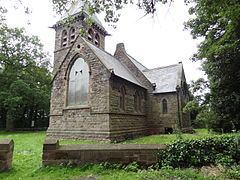Population 2,996 (2011 Census) Sovereign state United Kingdom Dialling code 01244 | OS grid reference SJ352688 Country Wales Postcode district CH5 Local time Saturday 6:54 PM Post town Deeside | |
 | ||
Weather 11°C, Wind NW at 11 km/h, 47% Humidity | ||
Sealand (Welsh: Gwlad-y-Môr) is a community in Flintshire and electoral ward, north-east Wales, on the edge of the Wirral peninsula. It is west of the city of Chester, England, and is part of the Deeside conurbation on the Wales-England border. At the 2001 Census, it had a population of 2,746 (1,342 males, 1,404 females), increasing to 2,946 at the 2011 census.
Contents
Map of Sealand, UK
Sealand is on flat land formed by land reclamation of part of the head of the estuary of the River Dee which had become heavily silted-up. It is on the A548 road, near the Chester dormitory communities of Blacon and Saughall and is a popular place of residence for people from both sides of the Welsh/English border. Welsh medium primary education is available three miles away in Shotton at the recently established 'Ysgol Croes Atti' whilst Welsh medium secondary education is available nine miles away in Mold at the long established 'Ysgol Maes Garmon'.
The River Dee flowed to the sea along the current border between Wales and England, until in the 18th century it was diverted into its present channelized course to try to improve ship access from the sea to Chester. That led to extensive land reclamation in the head of the Dee estuary. The River Dee Company (1741-1902) had a right to reclaim the marshes and build embankments following the re-alignment of the Dee.
Timeline
Airfield
RAF Sealand was originally a civilian airfield and was taken over by the military in 1916 for training. No. 30 Maintenance unit was formed there in 1939. In 1951 the station was taken over by the United States Air Force, and then handed back to the RAF in 1957.
As a result of defence cuts announced in 2004, RAF Sealand was closed in April 2006. There are currently plans for a major residential development on the land.
In popular culture
Orchestral Manoeuvres in the Dark (OMD), the globally successful new wave act from Wirral, recorded the song "Sealand" for their seminal 1981 album, Architecture & Morality.
